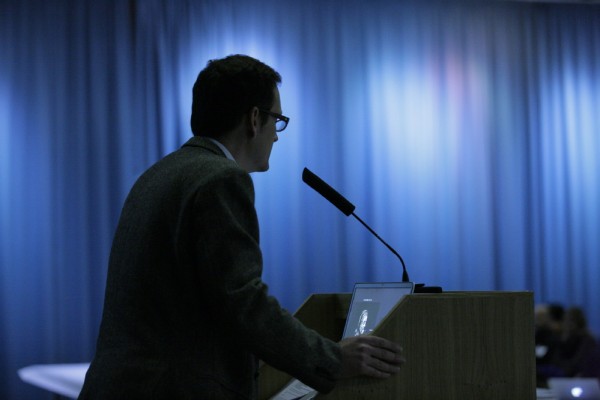It was certainly a fascinating 60 minutes. Understanding the various invasions of our fair city and the accompanying languages and letterforms brought by the marauding hordes helped give some context to the confusion which Geoffrey Chaucer sought to remedy. His decision to standardise the multiple regional options for words with essentially the same meaning was crucial to the emergence of a simpler, more easily replicated ‘middle English’. Clearer typographic forms to mirror this simpler language would still take some time to emerge.
coffee shop also seems to have played a central role in the development of the printing press in the 18th century, both as an industrial device for speedier reproduction of printed ephemera, and a means of distributing news through journalism. The practicalities of print meant that only several hundred copies of each daily paper (there were 12 or more different newspaper titles in the City of London in this period) could be distributed, and the coffee shops were a place where citizens could gather and consume the day’s top stories.
And the contribution of four generations of the Caslon family – from the creation of one of the first printing types to the development of one of the first sans serif typefaces – was also well described as a pillar of London’s typographic history. Sadly, but perhaps inevitably, the site of the Caslon letter foundry has now been developed (no doubt on multiple occasions) and only a blue plaque proclaims their fundamental contribution to our printing industry, indeed to the history of communication.
It is this same sense of loss that lies at the heart of OPX’s new initiative.
The aims of London Typographica are to be applauded. In a city that continues to transform itself, despite economic woes, there will be the constant erasing of the most wonderful examples of (mostly) physical typography. Putting the curation of these in the hands of the urban typo-geek is a masterstroke. Hopefully it will force people to look up, or closer, at the typographic furniture of London’s streets. The soon-to-be-launched application will make no judgement on the standard or aesthetic quality of the type. It will simply seek to record the example, and the location, of each piece.
In recording these changing typographic expressions, there is also an important parallel recognition of the crafts of signwriting and stonemasonry. The physicality these crafts bring to letterforms, and the variety of texture they once brought to this – and other great cities of the world – is every bit as important to architecture as the buildings on which they appear.

Antony Harrington
The loss of this world of typographic expression would be as sad as the gradual disappearance of hot metal type. As it is melted down, thrown away, and very occasionally saved, it – like open space lettering – represents an equally important but sadly all too impermanent symbol of the continued pursuit of clearer communication. Both deserve the attention of creative people across disciplines, worldwide.
That OPX has started this process, at their own cost, is as important as it is generous.
Text: Patrick Baglee











 Photo: Gerhard Kassner
Photo: Gerhard Kassner










![TYPO London 2011 in retrospect [Update]](https://dqdzq01yr6ixf.cloudfront.net/uploads/2012/02/Typo_London_places.png)
Pingback: Fontblog | TYPO London 2011 im Rückblick